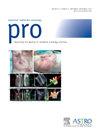Quantitative Assessment of Full-Time Equivalent Effort for Kilovoltage-Cone Beam Computed Tomography Guided Online Adaptive Radiation Therapy for Medical Physicists
IF 3.4
3区 医学
Q2 ONCOLOGY
引用次数: 0
Abstract
Purpose
With recent clinical adoption of online adaptive radiation therapy (oART) and the increased workload associated with adaptive radiation therapy (RT), proper staffing for medical physicists is paramount to safe clinical operation. However, there is currently no consensus on the full-time equivalent (FTE) requirements for safe administration of cone beam computed tomography (CBCT)-guided oART. This study aimed to quantitatively assess medical physics workload and staffing needs of a CBCT-guided oART program.
Methods and Materials
We conducted a detailed analysis of the CBCT-guided adaptive planning and treatment workflows, encompassing tasks such as patient consultation, treatment planning, plan review, training, quality assurance, and treatment delivery. Using data from machine logs, clinical database queries, and staff surveys, we present a framework for estimating FTE values for different staffing scenarios, considering medical physicists’ roles as planners, adaptors, or both.
Results
FTE calculations, based on an example workload of 100 adaptive and 200 nonadaptive patients per year, for 3 staffing scenarios were provided: medical physicists as planners and adaptors (2.9 FTE), medical physicists as planners but not adaptors (2.6 FTE), and medical physicists as adaptors but not planners (1.4 FTE). These findings offer calculation guidance and benchmarks for staffing requirements in CBCT-guided oART programs, emphasizing the need for specific staffing models to accommodate the complexities of adaptive RT.
Conclusions
This study outlines a framework for calculating FTE requirements for medical physicists in a CBCT-guided oART program. By analyzing the processes for 3 common adaptive RT workflows, this work can provide effective workforce planning and resource allocation estimates. This analysis can be used either before the implementation of an oART program, for program development, or as a review of current practices to ensure operational efficiency and proper staffing levels are maintained.
医学物理学家 kV-CBCT 引导在线自适应 RT 的全职等效努力定量评估。
简介:最近,临床上开始采用在线自适应放疗,与自适应放疗相关的工作量也随之增加,因此,为医学物理学家配备适当的人员对于临床安全操作至关重要。然而,目前对 CBCT 引导的在线自适应放疗的安全管理所需的全职等效人员(FTE)还没有达成共识。本研究旨在定量评估 CBCT 引导的在线自适应放疗项目的医学物理工作量和人员需求:我们对 CBCT 引导的自适应计划和治疗工作流程进行了详细分析,其中包括患者咨询、治疗计划、计划审查、培训、质量保证和治疗实施等任务。利用来自机器日志、临床数据库查询和员工调查的数据,我们提出了一个框架,用于估算不同人员配置情况下的 FTE 值,同时考虑医学物理学家作为规划者、适应者或两者的角色:根据每年 100 名适应性患者和 200 名非适应性患者的工作量示例,提供了三种人员配置情况下的 FTE 计算结果:医学物理学家既是规划者又是适应者(2.9 FTE)、医学物理学家既是规划者又不是适应者(2.6 FTE)、医学物理学家既是适应者又不是规划者(1.4 FTE)。这些研究结果为 CBCT 引导的在线适应性放疗项目的人员需求提供了计算指导和基准,强调了特定人员配备模式的必要性,以适应适应性放疗的复杂性:本研究概述了 CBCT 引导的在线自适应放疗项目中对医学物理学家全职当量要求的计算框架。通过分析三种常见的适应性放射治疗工作流程,这项工作可以提供有效的劳动力规划和资源分配估算。这项分析既可以在实施在线自适应放射治疗计划之前使用,也可以用于计划开发,还可以作为对当前实践的回顾,以确保维持运行效率和适当的人员配置水平。
本文章由计算机程序翻译,如有差异,请以英文原文为准。
求助全文
约1分钟内获得全文
求助全文
来源期刊

Practical Radiation Oncology
Medicine-Radiology, Nuclear Medicine and Imaging
CiteScore
5.20
自引率
6.10%
发文量
177
审稿时长
34 days
期刊介绍:
The overarching mission of Practical Radiation Oncology is to improve the quality of radiation oncology practice. PRO''s purpose is to document the state of current practice, providing background for those in training and continuing education for practitioners, through discussion and illustration of new techniques, evaluation of current practices, and publication of case reports. PRO strives to provide its readers content that emphasizes knowledge "with a purpose." The content of PRO includes:
Original articles focusing on patient safety, quality measurement, or quality improvement initiatives
Original articles focusing on imaging, contouring, target delineation, simulation, treatment planning, immobilization, organ motion, and other practical issues
ASTRO guidelines, position papers, and consensus statements
Essays that highlight enriching personal experiences in caring for cancer patients and their families.
 求助内容:
求助内容: 应助结果提醒方式:
应助结果提醒方式:


